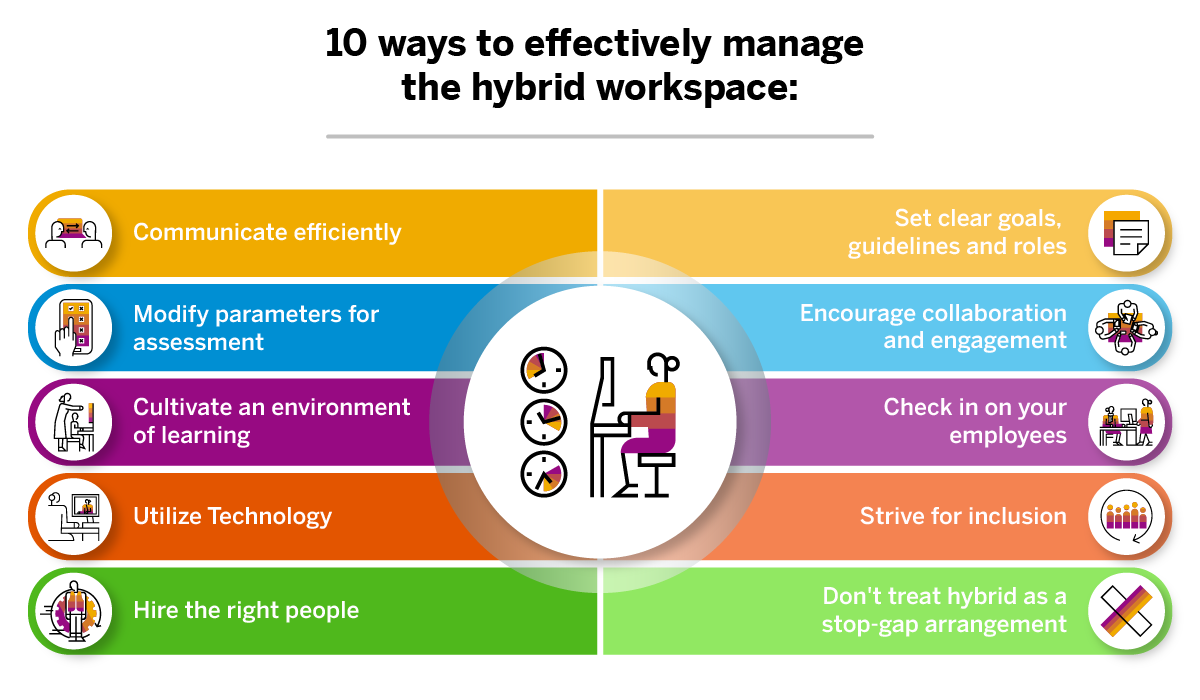As the Covid-19 pandemic continues to rage on unabated, it’s apparent that remote and hybrid working is here to stay. While shifting to remote work was hastened by the lockdowns, plans for hybrid working are less reactionary and much more deliberate.
According to Deloitte, 68% of 300 CEOs polled aim for their business workforce to function in a hybrid paradigm. According to a poll conducted by Nasscom and Indeed, around 70% of IT organizations are attempting to make the hybrid model work. Working remotely increased employee satisfaction for 66 percent of respondents, according to the survey. Complementing these findings is a study by McKinsey, which found that employees want at least two to three days of remote work- pointing to a strong push for the hybrid model. This just goes to prove that the hybrid work culture is taking the center seat in the business world.

However, these mixed working environments could create inequities and aggravate existing ones. For employers to guarantee fairness, maintain cultural cohesion and maximize performance in hybrid work arrangements, they should consider practical dimensions when designing hybrid work plans and navigating innovative ways of working. In this, they can be guided by tech-based tools and business analytics services.
Why should you consider a hybrid work model for your organization?
A hybrid workplace model is an excellent choice for businesses that cannot reach their true potential with the work-from-home system. Combining remote and office work has the potential to benefit your company in a variety of ways. Here are some of the several advantages to the hybrid workplace structure:
- Provides flexibility to employees: Hybrid models allow employees to work at their convenience. Employee satisfaction hinges on autonomy; employee happiness will rise if you give your team members complete autonomy and decision-making power over how, where, and when they work.
- Enables increased productivity: A hybrid strategy can empower people to work to their strengths, resulting in increased production. Teams can achieve a good balance of creativity and cooperation by promoting a culture that considers remote work as an alternative to completing deep-focus tasks in the office. Employees who require peace and quiet to concentrate or who thrive in an office atmosphere can work where and when they are most productive.
- Allows organizations to hire for skills: Employers can hire people according to the requirements of the business without worrying about their location. They can employ more local and remote talent, freelancers and contract workers.
- Is a cost-effective option: With controlled work hours in the office space, employers can cut down on costs for electricity, transport, office supplies, and more.
- Promotes collaboration: Many firms are better positioned to achieve meaningful innovation if their employees can collaborate face-to-face in the same area at least part of the time. It can be difficult for your firm to innovate and prosper when all staff work from home and can only meet digitally. Collaboration is made easier by traditional office-based work and its face-to-face interactions. It allows employees to mingle with their co-workers, chat during breaks, and share important ideas during casual in-person chats, all of which help them innovate.
- Improves visibility into employee performance: Employee performance is critical to the overall success of an organization because it enables managers to identify the strengths, weaknesses, and potential gaps that need to be addressed. Because they allow employees to integrate in-office and remote work seamlessly, hybrid work environments usually use more shared technology and collaboration platforms. Managers can easily observe staff activity on various tasks using these platforms, giving them a better picture of what everyone is up to.
How can you effectively manage and lead in a hybrid workplace?
There are many nuances associated with any new practice. Depending on the company culture, there will be aspects that each organization will have to personalize while adopting a hybrid work model. Leading a hybrid team necessitates adaptation to change and a willingness to try new things. However, with the help of effective management, this model can maximize productivity and be sustained over a long time.
Here are some ways to effectively manage a hybrid workspace:
- Communicate efficiently: In a hybrid workspace, constant and genuine communication is more crucial than ever. Keep channels of communication open, engage wisely, anticipate and address concerns and offer support to all, regardless of their job status.Establishing confidence with workers and showing them appreciation is an important part of the hybrid work culture. Recognize professional and personal triumphs. This will go a long way in fostering teamwork and encouraging the employees to give their best.The HR department could use some business analytics service and break through the all-too-common email clutter by exploring ideas like interactive surveys or videos for internal communications.
- Set clear goals, guidelines and roles: A team cannot work properly if they don’t know what they are working for. Clear communication, regular meetings and discussions on the progress achieved can enable seamless work and smooth collaboration. Roles and duties must also be strictly outlined when operating a hybrid workplace.Guardrails regarding punctuality, security, and the proportion of home-to-office hours will all be spelled out in a hybrid company policy. Establishing these open guidelines will prevent needless confusion and hassles.
- Modify parameters for performance assessment: Leadership must be adapted to the specific requirements of a hybrid team to get the most out of them. Precisely because of the peculiar nature of a hybrid environment, how employees are assessed should also change when necessary. Instead of measuring time, use milestones and deadlines to assess your team’s progress. One of the difficulties of remote work is ‘looking’ to be productive to management. Measurement, on the other hand, should not be viewed as a means of catching individuals out; rather, it should be used to guide staff toward achieving their objectives.Blanket policies and inflexible schedules can quickly kill the morale in a hybrid work setup. Avoid micromanaging or unnecessarily supervising remote employees since it will not only drain the supervisors’ energy, but will also demotivate the employees.
- Encourage collaboration and engagement: Employees who work from home can feel excluded from their teammates, unable to develop bonds that would have been very easy in a physical, face-to-face setting. This can lead to an ‘us versus them’ undercurrent among colleagues. The best method to combat this is to promote interaction and conversation.Consider alternatives to Zoom coffee conversations and happy hours, such as walk-and-talks, virtual coworking, music quizzes, open office hours, and buddy systems. This opens up opportunities for knowledge sharing and learning, even when working from home, which has traditionally been a challenge for younger employees who rely on older colleagues for guidance.Leaders and employees can add open (virtual) office hours to their calendars or status bars to encourage more spontaneous talks without disrupting people’s work. Anyone can phone that individual during defined time windows to bounce ideas off of them, chat about a problem they’re having, or just have a pleasant check-in.
- Cultivate an environment of learning: Whether there is a pandemic or not, a manager or leader should see their primary job as assisting employees. The times today are stressful, to say the least, with a worldwide health crisis, economic uncertainty, and persistent social turmoil. Employees are under a lot of stress, and it is a leader’s responsibility to reach out. Engage in socially distant conversations with co-workers and one-on-one video calls with remote employees. Inquire about their specific situations, as well as their concerns. You may have done a lot of this when the epidemic first started, but you should keep checking in as things evolve.
- Consistently check in on your employees: Having the correct tools can help ensure that collaboration happens smoothly, and that the employees are satisfied. A major source of frustration in professional spaces stems from utilizing a tool when the employees don’t know why they are using it, or when the tool doesn’t improve workflows and productivity. It’s also critical that the tools perform well in both synchronous and asynchronous environments. Tools and administration for the sake of it are fundamentally harmful, so putting the correct tools in people’s hands and listening to their comments goes a long way. If you are a small or midsize enterprise, you can look at leveraging the power of SAP Business ByDesign. It is a cloud-based, subscription ERP software designed for mid-market companies and subsidiaries.
- Utilize Technology: Having the correct tools can help ensure that collaboration happens smoothly, and that the employees are satisfied. A major source of frustration in professional spaces stems from utilizing a tool when the employees don’t know why they are using it, or when the tool doesn’t improve workflows and productivity. It’s also critical that the tools perform well in both synchronous and asynchronous environments. Tools and administration for the sake of it are fundamentally harmful, so putting the correct tools in people’s hands and listening to their comments goes a long way. If you are a small or midsize enterprise, you can look at leveraging the power of SAP Business ByDesign. It is a cloud-based, subscription ERP software designed for mid-market companies and subsidiaries.
- Strive for inclusion: When you’re leading a hybrid team, creating a fair and equitable environment is more difficult. There is a proximity bias that leads to the erroneous perception that ‘office workers are more productive than those who aren’t there.’ Leaders must implement procedures to resist this trend. It may be as simple as making it a rule that all team meetings take place over Zoom, even if some employees are at the office together. You must ensure that everyone on your team has an opportunity to make themselves heard, seen and recognized.
- Hire the right people: It’s critical to get the proper individuals in a hybrid workforce. Not everybody flourishes in a hybrid workforce, and not every sector is well-suited to flexible work schedules.
- Recognize that hybrid is not a stop-gap arrangement: A haphazard approach to hybrid work will almost certainly result in a haphazard response from the team. If you’re just biding your time until you can order everyone back into the office, it will show. The success of this hybrid method of working depends on a transformation in the workforce’s thinking as well as their talents. That notion should pervade everything you do, from employee technology to communication to processes and beyond.

Business analytics services and hybrid workspaces
Most employees have evolved to anticipate flexibility, and the hybrid workplace model encourages it. However, in terms of how office space is organized and managed, it presents new problems for real estate teams and workplace leaders. There is still a lot of uncertainty about how people will use offices after the pandemic. It’s difficult to determine what to do until business leaders understand how diverse employees will use the office in the new workplace landscape. As a result, business analytics services and the data gathered will be critical in optimizing the workplace and ensuring a positive employee experience.
Conclusion
By allowing employees in a variety of professions to work remotely, businesses have gained confidence in their ability to achieve high productivity and decrease workplace costs. Many companies are developing new hybrid approaches to their workforce, which not only line with individual demands but also better suit organizational needs, after seeing the many benefits of working remotely. Increased cooperation, change in corporate culture and empathetic management of all employees will ensure a proper balance between the digital and physical worlds. As some employees return to work, the focus should now shift to improving security, infrastructure, and employee experience to meet the evolving needs of a hybrid workforce.



